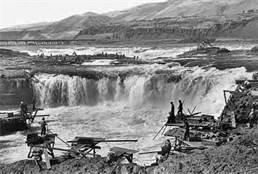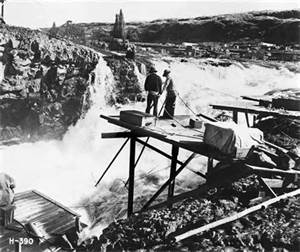by Leon Pantenburg
Last weekend, I had the honor of starting the fire for the annual Salmon Bake at Central Oregon Community College. I used the flint and steel method, with indigenous tinder and wood. (Murphy stayed away: I got the fire going with no problem.) In many tribes, starting the fire for a ceremony is part of the tradition.
 |
| Celilo Falls, on the Columbia River, about 1900. Settlements in the area go back at least 15,000 years. (Oregon Historical Society photos) |
The idea behind the COCC salmon bake was to recreate, as much as possible, a gathering that would celebrate the return of the salmon upstream.
Salmon were as important to the northwest indigenous people as the buffalo were to the tribes on the plains. The annual salmon run, when the fish returned upstream to spawn, was eagerly anticipated by the residents. For the duration of the run, which could be several weeks, the people harvested salmon, dried the flesh and socialized.
See the how-to video below
That tradition ended in the 1970s when the Bonneville Lock and Dam system flooded the Celilo Falls on the Columbia River.
"Celilo" is the name of a series of cascades and waterfalls on the river, as well as to the native settlements and trading villages that existed there in various configurations for 15,000 years.
All that remains of the salmon community is memories. One way to keep those memories alive is through the ceremonies and gatherings, such as the COCC Salmon Bake.
Every year, the Native American Club at the college hosts the Salmon Bake, which features dancing, story telling and the keynote salmon feast.
The head cook for the event was Geraldine Jim, 75, ably assisted by her husband Wilford. Geraldine, of Warm Springs, Oregon, learned how to cook salmon from her grandmother, and the recipe and technique goes back thousands of years.
 |
| Celilo Falls was the site of massive salmon runs, where the fish would concentrate on their way upstream to spawn |
The technique is simple, Geraldine Jim said, and relies on some skill and the correct types of wood.
Here's what you need, according to Jim:
- A campfire made of hardwood. Alder is preferred, Jim said, because pine or other soft woods will smoke and cause the salmon to blacken with soot and taste bad.
- Hardwood sticks, about three feet long and slightly curved. The bark should be removed.
- Skewers, about 12 inched long, and about 1/8-inch think.
- Filleted salmon with the skin still on.
- Lay the fillet skin side down, and insert the long stick next to the skin and push it through.
- Pin the fillet on the stick by pushing the skewer through the skin, through the flesh, then through the skin on the other side. Break off the ends of the skewers so they don't catch fire.
- Place the end of the stick in the dirt next to the fire. The distance from the end of the fillet and the ground should be about two hand widths.
- Slightly tip the top of the fillet toward the fire. The fillet should be about two to three feet from the fire.
- Cook about 45 minutes to an hour. When the fish is done, the skin will be dry.
No comments:
Post a Comment